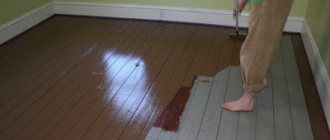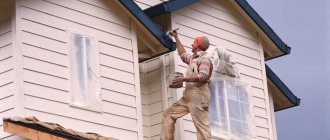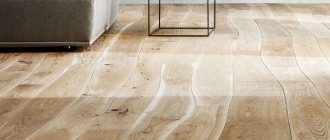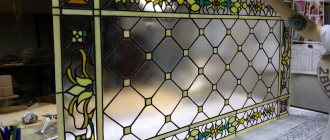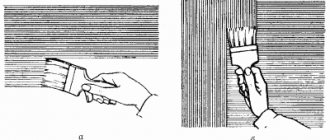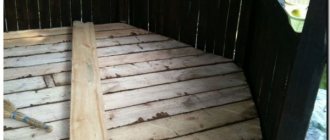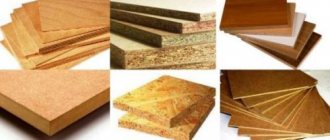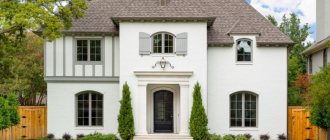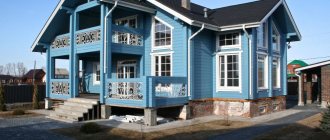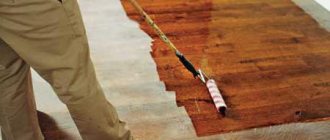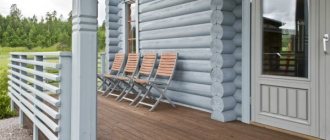by Alexey | Decor Workshop Cheap Interior | Friday, September 01, 2017
| Follow Make-Self.net on Facebook and be the first to read our articles. |
Painting the floor is a great solution to hide stains, scuffs and breathe new life into an old wood floor. Solid color, patterns or geometric shapes can dramatically change the atmosphere of the interior. Do not forget about the preliminary preparation of the floor for painting, the durability of the applied layer depends on this.
What can you paint with?
To choose the right paint coating, you should consider 3 important nuances:
- Wear resistance. The floor, unlike walls and, especially, the ceiling, is constantly exposed to stress: people walk on it with bare or shod feet, move furniture, rub with brushes and floor mops. In order for painted logs to retain their appearance for a long time, you should choose durable, reliable paints and varnishes intended for this type of operation.
- Scope of application. The floor surface itself is a problem area in any interior, and if you have to paint a wooden floor in an unheated or, especially, open room, the situation is aggravated by temperature changes and natural phenomena such as scorching sun or rain, snow, hail. The material must be as stable as possible.
- Design. If your style or personal preferences require preserving the natural texture of the wood, you can simply apply a clear varnish - matte, satin or gloss - to the sanded floor. Another option is wax or oil, but it is best to use them as a coating for wooden floors in heated spaces - houses, apartments. In other cases, use paint for a wooden floor - dark, light, colored.
Varnish
Alkyd, acrylic, and polymer compositions are suitable for covering a wooden base. Oil and essential varnishes are not used in finishing work; they are considered furniture varnishes.
The main advantage of varnishes is that they do not hide the texture, forming a dense transparent film. Even if the foundation is tinted, it will still only highlight the appearance and not hide it. Unfortunately, the varnish layer has not only advantages, but also defects: cracks, chips. To completely hide them, puttying is required, and then coating with opaque paint.
The photo shows a floor covered with glossy varnish
Wax, oil
Liquid oil and hard wax, unlike varnish or paint, do not create a noticeable film, but only block the pores of the wood. Due to this, the texture is emphasized and a waterproof barrier appears. The main disadvantage of this coating is its fragility. Oil should be renewed every year, wax - once every 2-3 years. For comparison, the varnish surface will “stand” for 10-15 years.
The photo shows oil applied to wood.
Paints, enamels
Do-it-yourself wooden floor under laminate
But this is not the only type of wooden flooring - there are also floors made of plywood, chipboard, and parquet. These floors are warm and environmentally friendly, but they are highly susceptible to various operational influences - from ordinary mechanical abrasion to moisture, which contributes to deformation.
At a certain point, when starting an apartment renovation, people wonder whether these old and terrible floors should be replaced with something new?
However, old wood floors are very difficult and expensive to remove, and in some cases almost impossible. But even if you have extra time, and there is a concrete slab under the boards - why all this hassle, this dust, and extra work when you can lay many new flooring, such as laminate, directly on top of the existing floor? In addition, wood is an excellent thermal insulation material, so why deprive yourself of additional protection?
But if you decide to do this, you still need to check and prepare the wooden floor for the laminate, since for long-term use of the laminate, you need a flat and strong base, and old floors, you see, do not fit this definition well.
Preparing wood floors is a labor-intensive task.
- First, you need to check the overall strength of the floor - whether the boards are attached well to the joists and whether they bend. If individual boards sag, you just need to attach them more firmly to the joists with self-tapping screws. If several boards bend at once, along with the logs, it is necessary to attach the logs to the base of the floor. This can be done using anchors that are used to install windows, or driven-in dowels.
- All protruding nails must be recessed; in some cases, a couple of self-tapping screws must be added nearby, just to be sure. Also drown it, in case the floor is relatively flat, when cleaning it, you won’t break the tool. Then check for evenness using a level and a long rule (or an even beam, at least 2 m long). If your floor differences do not exceed 2-3 mm per meter, you can safely proceed to laying the laminate, otherwise the floor will need to be further leveled.
- If the unevenness is within 5 mm, it is enough to sand or loop them. By hand or with a suitable tool, such as a sander.
- If there are slightly larger differences in the wooden floor under the laminate, use a planer or electric planer. Don't forget to check for evenness using the rule.
- Now, if there are gaps between the boards, they can be sealed with a self-leveling mixture or acrylic putty. Let it dry and you can begin laying the coating.
- If the differences are significant, or one corner is significantly higher than the other, it is better to use one of the methods suggested below for preparing a wooden floor for laminate.
- Leveling with plywood (chipboard, OSB) is the simplest method. The plywood is laid over the existing floor. This method can also be used if you doubt the strength of one or several boards. The thickness of the plywood should be 10-12 mm.
A little more complicated is leveling using self-leveling mixtures or PVA mixed with shavings. It must be taken into account that if these mixtures are used, the floor level will rise slightly.
The most difficult way - but which requires almost no additional purchases - is to adjust the support joists. The only problem is that to do this it is necessary to remove the floor boards, trim the joists, or fill them with small bars, and then lay the boards in the old places. And this, you see, is not much easier than completely dismantling a wooden floor.
Now that your floor is perfectly flat, you can safely lay the laminate and continue renovating your apartment. Just don’t forget to follow all the rules for laying laminate flooring if you want it to serve you long and well.
Features by type of premises
Floor preparation, choice of composition, application nuances depend on where exactly the wooden floor is to be painted.
Open room
Unglazed balconies, open verandas, gazebos without walls are painted exclusively with external (street) paints and varnishes. Choose frost-resistant paints that do not fade in the sun or peel off in the rain.
The photo shows the painting of the flooring on the open veranda
Closed unheated room
In country houses, summer outbuildings, and closed gazebos, it is important that the floor can withstand not only foot traffic, but also temperature changes and high humidity. Universal compositions are suitable, but it is better to choose enamel for exterior use.
Advice! Varnish is not the best choice for cold wood floors because... even frost-resistant varnishes are less durable than the same paints.
Closed heated
The easiest way to paint wooden floors in a house or apartment. Any paint marked “For interior use” is suitable for use. They cost less because they do not contain additional strengtheners and additives. Choose odorless paints or varnishes, wax or oil.
Coating compatibility
Rarely does anyone think about compatibility when choosing varnish for a parquet floor or paint for unheated rooms. However, the compatibility of the paint and varnish material and the surface for its application is one of the rules for high-quality painting.
As a rule, the manufacturer specifies such nuances on the packaging, so take a closer look at the description. You will spend a little more time choosing floor paint, but the excellent results are definitely worth it!
Source
What tools will you need?
Painting a floor is not much different from any other painting job, but the set of tools and necessary things is a little wider.
- Ditch, roller, brush. The roller, which is convenient to squeeze out in the tray, provides quick beauty over a large area. It’s more convenient to use a brush to carefully paint the joints behind the walls and go around the pipes.
- Masking tape. Paper tape will help protect walls, pipes and other elements that should not be painted.
- Wood putty, spatula. For smoothing out irregularities, sealing cracks and seams.
- Chisel. It has the opposite effect of putty - it helps to remove unnecessary protrusions.
- Primer. Used as a preliminary layer, improves adhesion, creates additional protection for wood.
- Solvent. It will help clean your brush and hands after work and remove random stains.
You may also need:
- Construction hairdryer. Effectively removes complex old coatings such as oil paint, even if the number of layers is more than 1-2.
- Grinding or scraping machine. For restoration of parquet before varnishing or waxing.
Oil formulations - possible, but be careful
Just 10 years ago, floors were mostly painted with just such compositions. But with the advent of new types of paints, they sank into oblivion. Although at the same time they have not lost their advantages. For example, this is resistance to temperature fluctuations, excellent protective qualities, thanks to which oil paints can be successfully used for painting coatings even on the veranda.
Oil composition for painting floors
The advantages include low cost compared to other paint and varnish products - this is the most budget option. True, there are several disadvantages. Many of them are quite significant:
- A pungent and strong odor that takes a long time to dissipate, which is why you will have to leave home for some period.
- Oil paints take at least 3-4 days to dry.
- Such compositions do not allow the surface to “breathe”, which is why cracks may appear in the wood over time.
- Due to the fact that oil compositions contain drying oil, it can change its color over time. As a result, the flooring will lose its attractiveness.
Recommendations for preparation
The final quality of work depends more than 50% on the preparatory stage. First of all, remove from the room everything that could interfere with painting (furniture, equipment). Clear the perimeter of the floor from baseboards.
A wooden floor treated with paint or varnish that has already begun to peel must be restored to its original condition - this is the only way that subsequent fresh layers will lie evenly on it. This can be done using heating (hair dryer), grinding, chemicals (special removers).
If the coating holds tightly, it is enough to sand the floor to a satisfactory condition and you can proceed to further actions.
- Masking large irregularities. If there are wide gaps between the lags, planks cut to width are tightly inserted into them. After the “patch” has taken its place, it is planed and sanded flush with the floor.
- Leveling out minor flaws. Armed with wood putty and a spatula (it’s better to have two on hand: a soft rubber one and a hard metal one), cover cracks, chips and other defects. Let the putty dry and sand with fine sandpaper.
- Protection before painting. Priming is an important step for wood. It is necessary not so much for better adhesion, but for additional protection. The primer penetrates deeply into the wood fibers, providing a barrier against pests, fire, fungus, and destruction.
Laws of color selection
The color range of floors and doors is a little more limited than when decorating walls with wallpaper or painting. However, when you come to the store, you will see a fairly wide range of shades of laminate, parquet boards, linoleum, baseboards or tiles. The first thing you need to determine is what kind of floor you need - dark or light. Both options are good and appropriate if used for the right room and design.
What effect does the floor shade create?
- a light shade is an excellent light reflector and space enhancer. Additionally, it gives the space a clean and fresh feel when paired with a light shade on the walls. This is a universal solution for the living room and bedroom. However, if you combine light floors with cool wallpaper, you may end up with an uncomfortable atmosphere. This is especially true for the northwestern location of the rooms;
- a dark shade is stability, style and bright contrast, provided it is diluted with light wallpaper for walls, furniture and decorative elements. The combination of a dark floor and the same doors can add gloom. Whereas the use of contrasting accessories to match the floor against a general light background looks very harmonious. But this solution is only suitable for rooms that receive enough sunlight.
There are convenient special online applications that help you choose the right color combination of the floor to the wallpaper and other finishing elements in the apartment.
One of the fashionable techniques is a play of contrasts, when a white floor is combined with almost black furniture and vice versa. The same goes for the color of doors that contrast with the floor. Such techniques will negate the possible excess of white and the heaviness of black.
How to paint yourself?
Painting a wood floor is no more difficult (and maybe easier!) than any other surface. The main thing is to follow simple step-by-step instructions:
- Cover all areas that need to be protected from pigment with paper tape. Including walls adjacent to floor boards.
- Open a can of paint and stir the contents well to evenly distribute the fillers. Pour some into a cuvette.
- Use a small thin roller or a suitable brush to outline the room along the walls.
- Use a large roller to paint the entire floor area, moving from the far corner to the exit. Leave until completely dry.
- Apply a second coat of paint, repeating steps 3 and 4.
Important! If you plan to install floor skirting boards to be painted in the color of the floor, they are installed immediately after the preparatory work and painted simultaneously with the boards.
After completing all work, give the paint at least 24 hours - during this time the coating will become harder and will not be scratched if accidentally hit by furniture.
Advice! Before moving furniture in, check the quality of the floor paint: if, when the boards have dried, the material has run off a little and bald spots have formed, it is better to cover them up right away.
To make sure that anyone can handle painting and not miss a single stage of the work, watch the video:
Materials for puttying
To ensure that painting the floorboards goes smoothly, you should use high-quality putty to seal defective areas.
Various hand-prepared mixtures can be used as an alternative floor putty for painting:
- large cavities can be filled with tow soaked in an aqueous adhesive solution (15% glue content);
- sawdust putty is known, where, as the name implies, small sawdust is used, mixed with ordinary PVA glue or oil-based floor putty.
There are also two main types of commercial putties: adhesive and semi-oil (read: “What kind of floor putty is needed and how to make it”).
- add 100 grams of turpentine to 4 liters of oxol;
- add 1 liter of aqueous solution with soap;
- about 2 liters of a 20 percent adhesive solution is poured.
- mix 0.5 kilograms of wood glue with 5 liters of water;
- add 1.5 kilograms of drying oil or oxol;
- add water (by eye) to thin the solution;
- Based on the added volume of water (no more than 1 liter), 100-150 grams of soap are added to it.
Features of applying varnish
On the one hand, it may seem that varnishing is no different from painting. But in reality the processes differ markedly from each other.
Firstly, if it is better to take a roller for paint, then for varnish it is better to use a soft, wide brush. Secondly, it is important to varnish at a temperature of 15-25 degrees above zero.
Let's get started:
- Carefully move the polish around inside the can. If you plan to use a brush, you don’t have to pour the contents into the tray.
- Apply the first coat along the grain of the wood, carefully going through each joist and spreading the varnish thinly. Leave until completely dry (time indicated on the package).
- After the first layer, you may notice that the fibers have risen a little - take a block, fine sandpaper and go over the entire floor area to remove unevenness.
- Carefully remove any accumulated dust using a vacuum cleaner and a clean cloth. It is recommended to wash a smooth polished floor 2-3 times.
- Apply a second coat of varnish.
- Sand and wash the floor again.
- Apply a third coat of varnish. It is essential for pine floors. Hardwood can only be coated twice.
Important! The finishing coating is not sanded: to remove the sticky layer, it is enough to wash the floor after drying with a soap solution.
Detailed video instructions will help you put everything in its place:
The order of preparatory work before painting
Before painting a wooden floor, you need to prepare it to ensure a smooth surface.
The procedure includes:
- Remove disturbing objects and wash the floor.
- Remove old paint and, if there are dents, sand them down.
- Cracks are filled with putty, most often in several layers; it is important to wait until each layer dries.
- The surface is sanded again so that it becomes as smooth as possible, the paint coating is glossy and even.
- Apply priming with a composition suitable for the type of paint, this will help to obtain better adhesion.
A carefully prepared surface will ensure a good result.
Apply priming with a composition suitable for the type of paint, this will help to obtain better adhesion.
Original painting ideas
The easiest way to make a monochromatic floor covering is to simply paint it one color around the entire perimeter. But if you want something more original, you can arm yourself with patience and create a unique pattern.
For example, alternating white and wooden diamonds: simple, fast, impressive. First of all, paint some of the squares white, then cover the entire area with a couple of layers of varnish.
The photo shows an unusual way of painting the floor
Geometric 3D painting looks no less original - to implement it you don’t even need to have artistic talent, you just need to figure out where and what shade to apply.
Are you afraid of making a mistake when modeling manually? Use stencils! You can purchase ready-made ones or order them from a printing house to suit your taste.
One last idea - add some color! The technique of multi-colored staining looks best on small-format floors, such as parquet. The only negative is that you will have to tint many shades to get a spectacular result.
Floor paint is a budget-friendly, but nonetheless workable option for finishing boards. By choosing the right composition and following all the recommendations, you will create a durable floor covering with your own hands.
Safety precautions
Almost all work associated with painting floors with any dyes is flammable and toxic. Smoking in areas where paint and varnish work is carried out can lead to death.
When painting the floor, do not forget to ventilate the room
All rooms should be well ventilated during painting. Workers must wear respirators and safety glasses. The painted floor is dried for a long time until the fumes completely disappear.
Pros and cons of decorating the floor
Advantages and disadvantages
with the help of available paints and varnishes the appearance of the floor is transformed;
paint allows you to create a unique coating;
using dyes and stencils you can draw ornaments and patterns;
the painted surface is protected from moisture and mechanical damage;
the coloring composition extends the service life of the floor;
the painted surface is easier to care for;
The coating protects the floor from the development of fungi and destruction by insects.
most paints and varnishes have a high price;
solvent-based enamels have a strong odor and toxic composition;
To create ornaments and patterns, you will need to buy several types of paints and varnishes.
Draw by hand
If you love to draw since childhood or in your spare time you constantly paint sketchbooks in unusual colors, then why not take your hobby into the interior? You can make several stencils, apply an outline with them (for example, these could be flowers), and then hand-paint each leaf and decorate it with intricate patterns.
The main advantage of such a floor is that it will be unique, since you painted it yourself. If you have children, they will certainly want to take part in such a fun activity.
